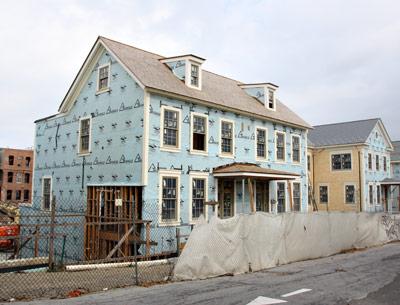Big Bulova Questions

Last week Save Sag Harbor, a not-for-profit group of volunteers, was able to persuade the developers of the Bulova watchcase factory to stop cladding the exterior of the project’s town houses with synthetic materials. But it’s too late to do anything about the scale of the buildings, which they argued were out of sync with the village’s architectural vernacular.
It was all in a day’s work for the members of the group, which was formed in 2007 to stop a national chain from putting a 17,000-square-foot pharmacy on Main Street. Their efforts paid off. Not only would it have “seriously impacted” the thoroughfare’s established drugstore, five-and-dime, and stationery shop, the group believed it would have destroyed, in one fell swoop, the character of the village.
“We want to keep . . . a working village that’s more than a tourist destination,” said one of its board members, Myrna Davis, a writer who lives on Rector Street with her husband, the well-known illustrator Paul Davis. The group drummed up “overwhelming support” to prevent the potential debacle. It has since taken on other projects, notably the redevelopment of the Harbor Heights service station and a proposed condominium development at One Ferry Road. It has hired an attorney, Jeffrey Bragman, to represent it at numerous hearings.
The Bulova project actually wasn’t in their purview, Ms. Davis said. In fact, Save Sag Harbor had supported what they hoped would be a “first-class restoration of this important historic building and grounds.”
However, when several neighbors of the project approached Save Sag Harbor members with complaints, the board took action. In a letter to the Sag Harbor Architectural Review Board, the group called the new town houses being built in connection with the restoration of the old watch factory “more than disappointing.” The letter cites the scale of each house as “too big for the surrounding properties,” and calls the materials “inappropriate for a 300-year-old historic village that is a locally and nationally designated historic district.”
The letter goes on to say that past “approvals by the Sag Harbor Village Architectural Review Board are “inexplicable in light of the written criteria guiding its decisions, which expressly state that synthetic materials should be avoided. Such materials have not been approved for individual homeowners, despite hardships, and the larger the scale of the project, the more adverse the impact of disregarding the criteria.”
Ms. Davis, along with Bob Weinstein and Susan Mead, attended the Oct. 28 meeting of the A.R.B., where the trio waited two and a half hours for Bulova to come up. While waiting, they inserted themselves into discussions of other proposals. When the owners of InHome, a shop at 132 Main Street, proposed installing a picture window, Ms. Mead said it could jeopardize other properties because it compromised the area’s designation as a historic district.
Owners of properties near Bulova also attended the meeting, including Eliza Werner of Sage Street Antiques, who said she was there to keep an eye on what Cape Advisors, the project’s developers, were doing. Her shop is in an old house and, she said, she was concerned that the row houses are “towering over me.”
By 7:30 p.m., when representatives of Cape Advisors began their presentation, anticipation had built to a peak. More than half a dozen people left their seats and hovered around the table where review board members were viewing drawings. The developers explained that they had met with some members of Save Sag Harbor earlier in the day and had agreed to various changes, including replacing fiber-cement siding with cedar shingles.
When all was said and done, a woman was told that it was too late to read a letter from Carl Peterson, who works with Ms. Werner at Sage Street but was unable to attend. Ms. Davis, however, persuaded the board to hear the letter quoted above.
Some of the points made in Mr. Peterson’s letter were that the town houses are “too close to each other,” materials “appear to be plastic,” and the color combination is “jarring.” He wrote that the overall effect was “creating a Disney Land-like horror show.”
The meeting almost seemed redundant. Having already met with members of Save Sag Harbor, the developers appeared ready to make changes. “Clearly we need a strong A.R.B. as the first line of defense,” said Jayne Young, a board member who is former president and publisher of The Atlantic Monthly. “But many hands make an impact; it’s a collective effort.”
Meanwhile, Save Sag Harbor is focusing on Harbor Heights. (The Sag Harbor Zoning Board will meet again on the station’s plans on Nov. 19.) “This is the first big test of the new zoning code,” which was established in 2009. Ms. Young called the planned 96-foot-long pump island and canopy, which had been reduced from 102 feet, “still a huge intensification of the property. . . . We now have a run-down country gas station that’s being converted into something on steroids.”
“People on the East End have a great sense of place,” Ms. Young said. “If we want to keep what we cherish people do have to be involved.”
